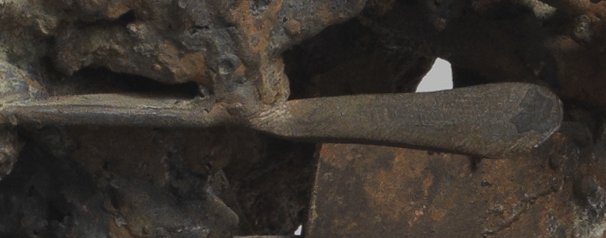Spoon Handle
Here is a flattened section of steel with a semi-circular end that tapers into a more narrow piece of wire. The item closely resembles a cutlery handle, such as that of a tea spoon. Simple steel cutlery was common in the early and mid 20th century, with most people unable to afford sterling silver. But regular steel cutlery rusts over time, as we can see with this handle, and can add an unpleasant taste to some foods.
Stainless steel, which is made by adding chromium to regular steel, does not rust or tarnish food. It was invented by Harry Brearley in Sheffield, England in 1913. Brearley’s stainless steel became very popular as a cheaper alternative to silver cutlery and spread throughout the world. It remains the most common material for cutlery production today. Perhaps this spoon was thrown into the scrap heap after being replaced by a non-rusting stainless steel counterpart.
Another cutlery handle, this time from a larger table spoon or fork, is just about visible on the other side of the sculpture. The inclusion of these domestic items, in contrast to the more industrial nuts, bolts and screws, speaks to the title of the piece – Habitation, meaning dwelling place, or home.



